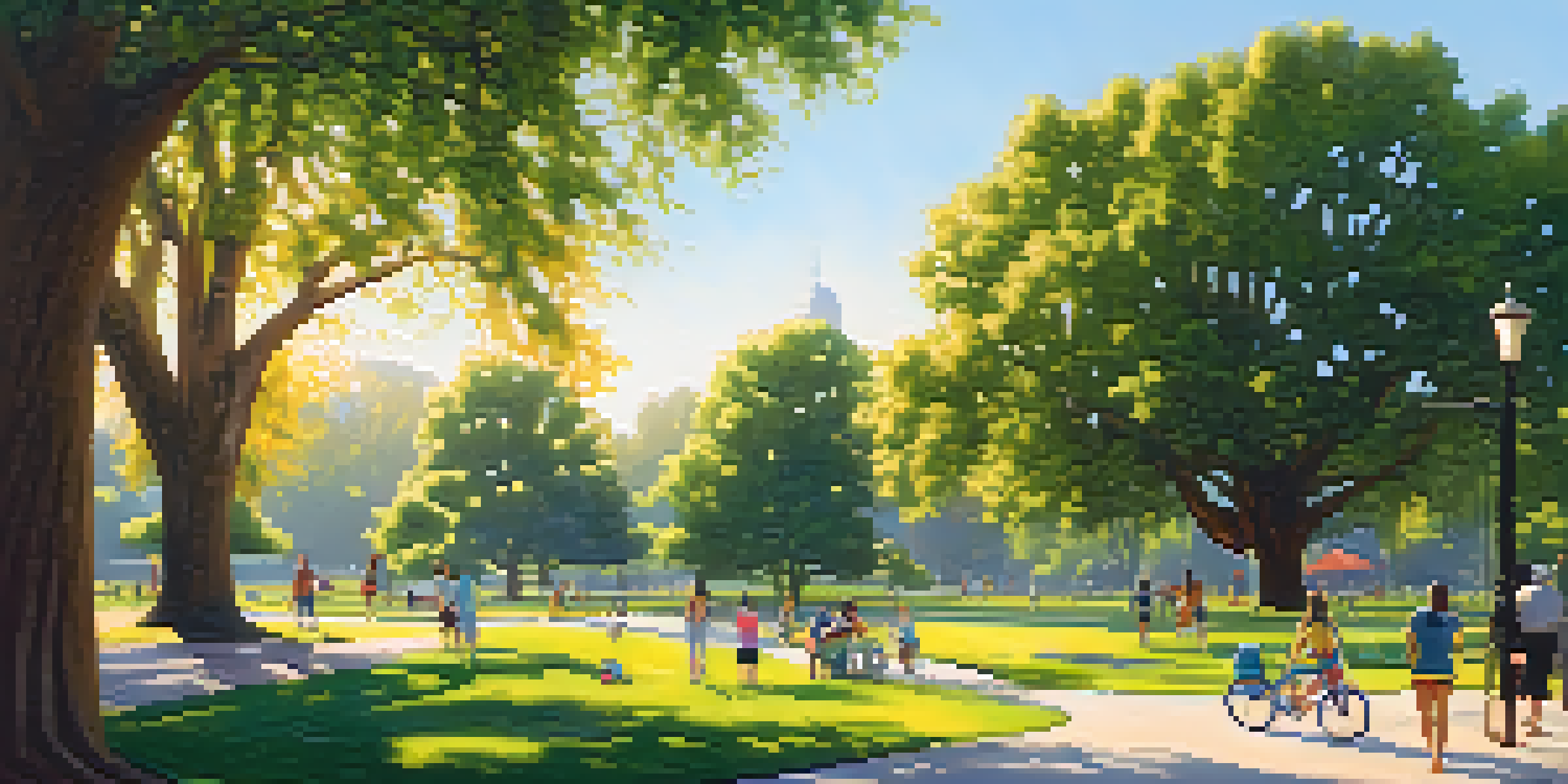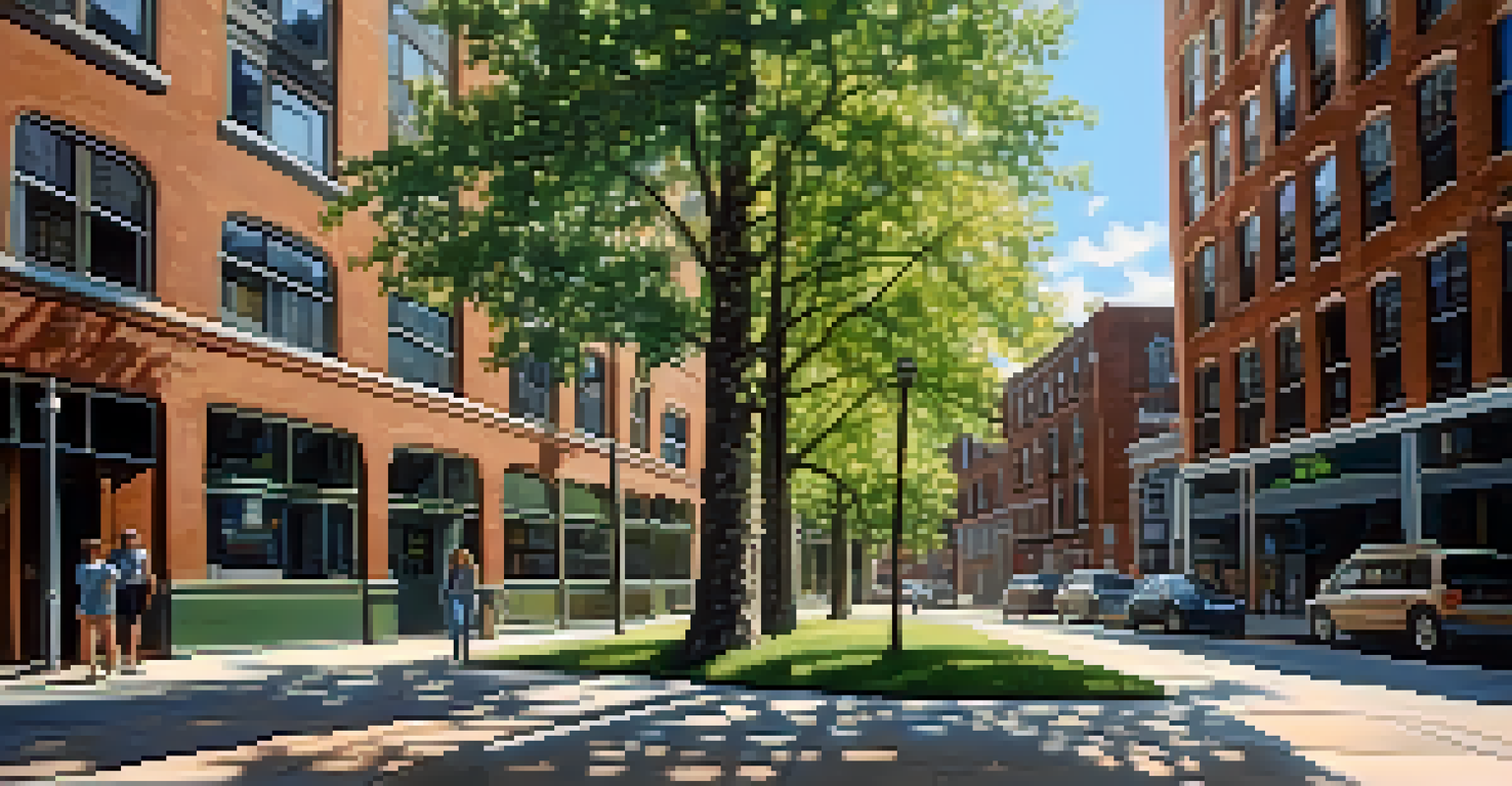The Importance of Urban Forestry in Sacramento’s Ecosystem

Understanding Urban Forestry and Its Significance
Urban forestry encompasses the management of trees and green spaces in cities. In Sacramento, this includes not only the trees lining the streets but also parks and other green areas. These spaces play a crucial role in maintaining the ecological balance within urban environments.
The best time to plant a tree was twenty years ago. The second best time is now.
The significance of urban forestry extends beyond aesthetics; it provides essential services such as air purification, temperature regulation, and biodiversity support. For instance, trees absorb carbon dioxide and release oxygen, making our air cleaner and more breathable. They also help moderate urban heat, creating cooler microclimates in the city.
By understanding urban forestry, we can appreciate its multifaceted benefits. It fosters a healthier city environment, enhances community wellbeing, and supports wildlife, making it a vital component of Sacramento’s ecosystem.
The Role of Trees in Enhancing Air Quality
Trees are nature's air filters, absorbing pollutants and improving air quality. In Sacramento, where air quality can be affected by various sources, including traffic and industry, urban forestry plays a crucial role. A single mature tree can absorb approximately 48 pounds of carbon dioxide annually, significantly contributing to cleaner air.

Moreover, trees release oxygen through a process called photosynthesis, which is essential for all living beings. In urban settings like Sacramento, where the population is dense, maintaining a robust tree canopy can help reduce overall air pollution levels and promote public health.
Urban Forestry Enhances Air Quality
Trees act as natural air filters, improving air quality in Sacramento by absorbing pollutants and releasing oxygen.
By planting and maintaining trees, Sacramento can enhance its air quality and ensure a healthier environment for its residents. This is especially important as climate change continues to pose challenges to urban air quality.
Urban Forestry’s Impact on Temperature Regulation
Urban areas often experience the 'urban heat island' effect, where temperatures are significantly higher than in surrounding rural areas. Trees mitigate this phenomenon by providing shade and releasing moisture through a process known as transpiration. In Sacramento, where summer temperatures can soar, urban forestry helps create cooler, more comfortable public spaces.
In every walk with nature one receives far more than he seeks.
For example, shaded parks and tree-lined streets can lower temperatures by several degrees, making outdoor activities more enjoyable for residents and visitors alike. This cooling effect not only enhances livability but also reduces energy consumption in nearby buildings as the need for air conditioning diminishes.
In essence, urban forestry is not just about aesthetics; it's about creating a more sustainable urban environment that can adapt to rising temperatures and climate change.
Supporting Biodiversity in Urban Areas
Biodiversity is crucial for a healthy ecosystem, and urban forestry plays a pivotal role in supporting various plant and animal species in Sacramento. Trees and green spaces serve as habitats for birds, insects, and other wildlife, allowing them to thrive even in urban settings. This biodiversity adds vibrancy to the city and enhances its ecological resilience.
By planting a diverse range of tree species, Sacramento can attract a variety of wildlife and promote ecological balance. For instance, native species often provide food and shelter for local birds and pollinators, helping to maintain the region's natural heritage.
Green Spaces Boost Community Wellbeing
Access to parks and green areas promotes physical health, reduces stress, and fosters social connections among residents.
Urban forestry, therefore, not only beautifies the city but also fosters a rich tapestry of life, contributing to environmental health and community pride.
Enhancing Community Wellbeing Through Green Spaces
Access to green spaces has been linked to numerous health benefits, including reduced stress, increased physical activity, and improved mental health. In Sacramento, urban forestry initiatives create parks and green corridors that serve as vital recreational spaces for the community. These areas encourage social interaction and provide a serene escape from urban life.
Research shows that spending time in nature can lower blood pressure and enhance mood, making urban forestry an important aspect of public health. By investing in trees and green areas, Sacramento is prioritizing the wellbeing of its residents, promoting a more active and connected community.
Ultimately, urban forestry establishes a sense of place and belonging, enriching the lives of those who call Sacramento home.
Economic Benefits of Urban Forestry
Urban forestry also brings significant economic advantages to cities like Sacramento. Trees enhance property values, with studies indicating that homes near well-maintained green spaces can sell for more than those without. This increase in property values benefits homeowners and generates higher tax revenues for the city.
Moreover, urban forests can attract tourists and businesses looking for vibrant, green environments. Parks and tree-lined streets are appealing to visitors, encouraging them to explore the city and spend money in local businesses, thus boosting the economy.
Economic Benefits of Urban Trees
Urban forestry increases property values and attracts tourism, contributing to the economic growth of Sacramento.
In this way, urban forestry is not just an environmental asset; it's an economic driver that supports community growth and sustainability.
Community Involvement in Urban Forestry Initiatives
For urban forestry to thrive, community involvement is essential. Sacramento residents can participate in tree planting events, maintenance programs, and educational workshops that promote awareness of the benefits of urban forestry. Engaging the community fosters a sense of ownership and responsibility towards local green spaces.
Additionally, local organizations often collaborate with the city to organize tree care and planting initiatives. These partnerships not only help to enhance urban forestry efforts but also create opportunities for residents to connect and build relationships with one another.

When communities come together to support urban forestry, they cultivate not only trees but also a stronger, more united city.
The Future of Urban Forestry in Sacramento
As Sacramento continues to grow, the future of urban forestry will play a critical role in shaping the city's landscape. Sustainable practices, such as using native species and innovative planting techniques, will be essential for maintaining healthy urban forests. By prioritizing these strategies, Sacramento can adapt to changing climate conditions and urban challenges.
Moreover, ongoing community engagement and support from local government will be vital in ensuring the success of urban forestry initiatives. This collaborative approach will help build a green legacy for future generations, fostering a culture of sustainability within the community.
In summary, the future of urban forestry in Sacramento looks promising, with the potential to enhance environmental health, community wellbeing, and economic vitality.